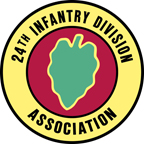The 21st Regiment on the Philippine Islands
From a typed, half-inch thick spiral-bound well-illustrated book by
Life Member 507, Guy E. Sheppard, Sr.
We, the 21st Infantry Regiment, encountered the formidable center of the Japanese line on April 30 for seven weeks of hard and continuous combat. The 1st Battalion, that’s us, commanded by Maj. Nick Sloan, bypassed Libby Airdrome on our west and drove directly on to Mintal, arriving there on May 3.
The rest of the 21st Regiment took Libby Airdrome on May 5, but could advance no farther up Route 1D. That put our 1st Battalion at Mintal in the serious position of being surrounded and possibly annihilated. Fortunately, we held ‘em off.
Then on May 8, we crossed the Talomo River near Mintal but enemy artillery, mortar and machine-gun fire put us back across the river two days later.
The east bank of that river looked like the walls of the Grand Canyon. Machine-gun fire was coming right down on us from up there. The river was only about waist deep but the current was so swift you could not stand upright without something to hold on to.
No sooner had we stretched rope and secured it to hold on to, the Japanese would open up on us with their machine guns and woodpeckers. It was the pits — we lost a few guys with wounds but we made it across.
But when we did all kinds of hell broke loose. Artillery and mortar rounds bursting all around, and those infernal machine guns wouldn’t let us hide anywhere. After two days of this we went back across the Talomo to regroup.
The 52nd Field Artillery was then brought in, but their first round was no help at all; it fell short, right on one of our guys. After the artillery barrages, we left to cross the river again. I saw a GI boot with part of a leg still in it. Those short rounds happened, just one of the bad breaks in war.
On May 12, the 1st and 2nd Battalions started north along the east bank of the river toward Mintal. Over the next three days we cleared Route 1D, to Mintal.
We then fought our way into Mintal but when we did the fighting even intensified. Holy cow, where did they all come from!
When we left Mintal there were Japanese bodies lying everywhere in the streets. The severe temperatures caused the bodies to swell until the arms were extended. It was common to see the enemy dead like this everywhere. There was no organization left in their Army—no one to pick up their dead, and no one to notify their families of their misfortune.
That’s the horrors of war. If the men in government who start wars had to do the fighting, there would be no war, and you can bet your ass on that.
We started our march to Davao, and dug in for the night. Before daybreak I was summoned to the Headquarters area in the center of our perimeter. Capt. Irons asked Sgt. Land, Smitty and me to check out an intersection in the road ahead. A patrol had reported hearing digging, and Irons wanted to know what was there before he moved the company up the road.
He told us to go through the edge of the jungle beside the road, and figured three men could travel faster with less. We arrived at the intersection as light was breaking and saw a pillbox bunker in the edge of the jungle; its slits directly pointing down the road.
Sgt. Land waited outside the bunker to cover us while Smitty and I lowered ourselves into it. There were two Japanese asleep inside. Our Thompsons ensured that they went to permanent sleep.
A 20mm anti-aircraft gun was pointed down the road that our company was about to come along. Smitty and I removed the gun and handed it to Land, who put it over his shoulder, and we returned to the Company. Irons was glad to see us, and even happier when he saw the cannon.
He said we had saved the lives of some of our Company men, and that he was going to put us in for a Silver Star. But it never happened. I was 23 years old then; I am 78 now, and my Silver Star still hasn’t been awarded.
The Company moved to the area of the bunker, formed into a skirmish line and started moving on through the area. But the area was still lousy with the enemy; Smitty was killed by the first volley!
I was easing along in a crouch when I spotted the trunk lid of an old car. It was being used as a Japanese foxhole lean-to cover. I looked in and saw three bodies in the hole and started to move on.
But then I noticed that some did not have any blood on the bodies. I stuck my Thompson in there and let loose a burst. The guy in the middle nearly jumped out of the hole with his rifle in his hands, but the Thompson’s .45’s had done their job and he fell back motionless. I often wondered what would have happened to me had I turned my back and kept on walking.
I did not sleep well that night, I knew for sure that I had taken the life of another human being. I prayed to God about it but don’t know if I will be accountable at judgment day or not—I pray not.
Guy E. Sheppard, Sr., 13340 Willow Springs Road, Haslet, TX 76052-2819, Ph: 817-439-3397
The Taro Leaf, Vol 63(2) Spring 2009, pg. 18-19.

_small.jpg)
_small.jpg)